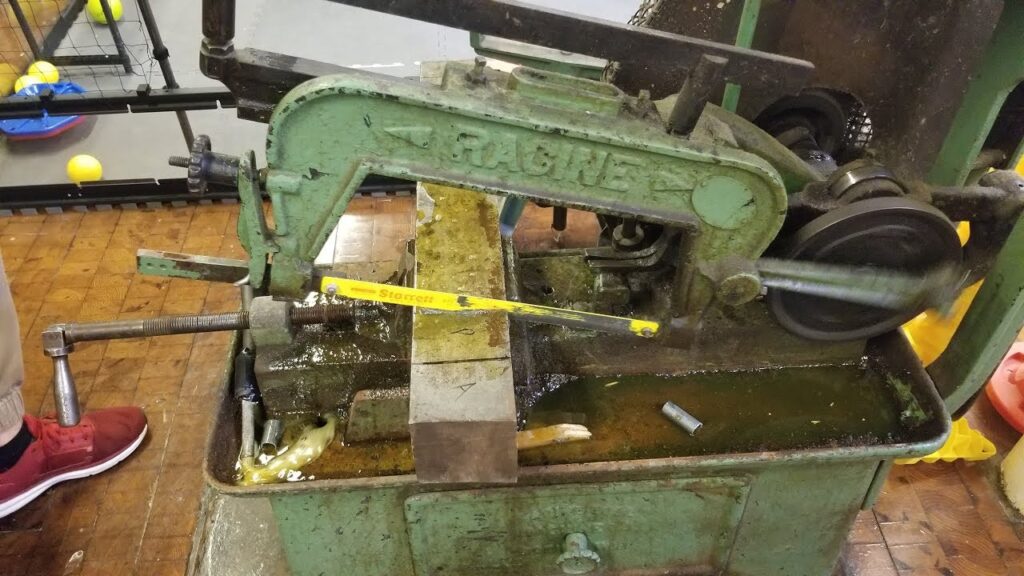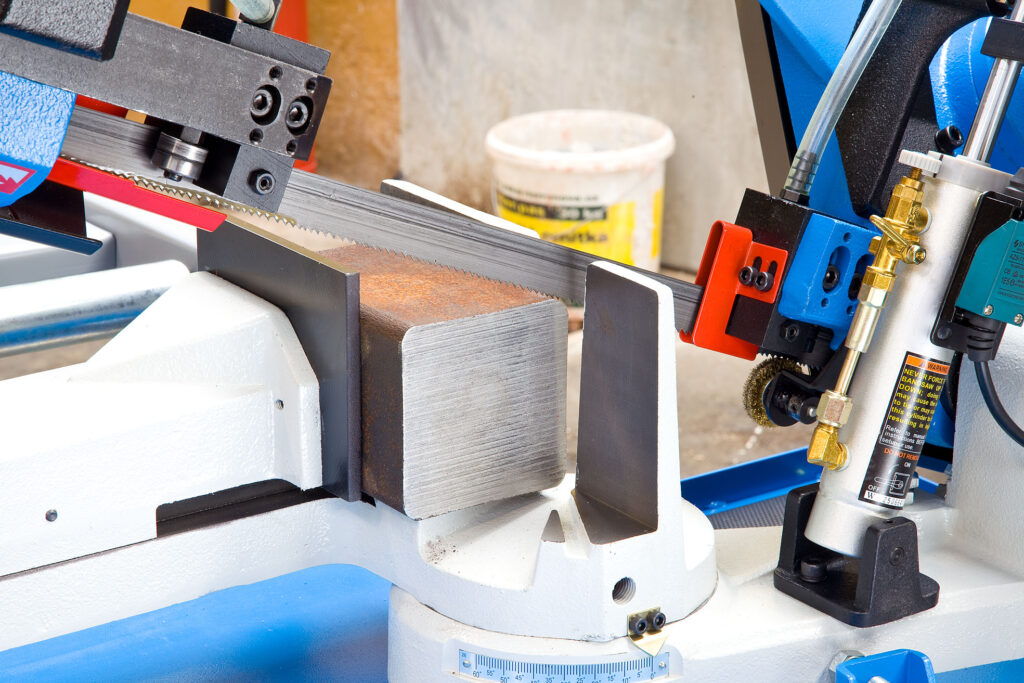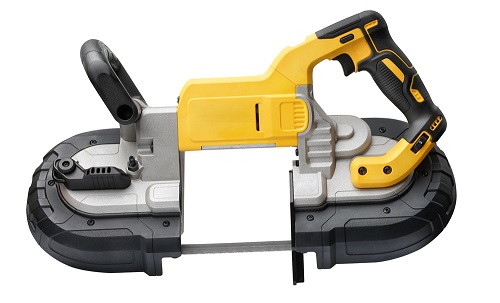When cutting through metal with precision and efficiency, two heavyweights in the machining world stand out: the power hacksaw and the bandsaw. These two formidable tools have been at the forefront of metalworking for decades, each with unique advantages and applications. In this comparison, we’ll delve into power hacksaws and bandsaws, dissecting their differences, strengths, and ideal use cases.
So, whether you’re a seasoned metalworking enthusiast or just beginning to explore the realm of cutting-edge machinery, join us as we explore the intricacies of power hacksaw vs. bandsaw and discover which one reigns supreme for your specific needs.
POWER HACKSAW: Unleashing the Ultimate Cutting Machine
The power hacksaw stands as a testament to precision and efficiency in power tools. Its ability to easily cut through various materials has made it an indispensable tool for many industries.
Evolution of the Power Hacksaw
The history of the power hacksaw dates back to the 19th century when it was first introduced as a manual tool. Over the years, it underwent significant transformations, evolving into the automated marvel we know today. The development of electric motors and advanced engineering techniques played a crucial role in this evolution.
Early Innovations
The concept of a powered hacksaw was born out of the need to improve cutting efficiency in metalworking and woodworking industries. In the late 19th century, inventors began experimenting with mechanical solutions to automate the cutting process. These early machines were driven by steam engines and required manual supervision.
Transition to Electric Power
The 20th century saw a remarkable shift towards electric power. With the advent of reliable electric motors, power hacksaws became more accessible and efficient. Electrically powered hacksaws offered greater precision and control, making them ideal for cutting tasks.
Modern Power Hacksaws
Today, power hacksaws have reached their pinnacle in performance and precision. They have advanced features like variable speed control, automatic feed mechanisms, and digital displays. These innovations have made modern power hacksaws indispensable in the manufacturing and construction industries.
Applications across Industries
Here are some key sectors where power hacksaws find extensive use:
1. Manufacturing
Power hacksaws are used in manufacturing plants to cut raw materials such as metal rods, pipes, and bars. Their precision and repeatability ensure that each cut meets the required specifications, contributing to the overall quality of the finished products.
2. Construction
The construction industry relies on power hacksaws to cut various construction materials, including steel beams and concrete rebar. These machines help ensure that construction projects progress smoothly and safely.
3. Automotive
In the automotive sector, power hacksaws are used for cutting metal components, frames, and exhaust systems. The precision of these machines is vital in maintaining the structural integrity of vehicles.
4. Aerospace
In aerospace manufacturing, where precision is paramount, power hacksaws are used for cutting aircraft components. Their ability to make clean, accurate cuts is crucial for air travel safety.
Benefits of Using a Power Hacksaw
Investing in a power hacksaw offers several advantages:
1. Precision Cutting
Power hacksaws are designed to make precise cuts, reducing material wastage and ensuring that each piece meets specifications.
2. Time Efficiency
Compared to manual hacksaws, power hacksaws can complete cutting tasks in a fraction of the time, increasing productivity.

3. Safety
Automated features and safety mechanisms minimize the risk of accidents, making power hacksaws safer.
4. Versatility
Power hacksaws can cut through various materials, including metal, wood, and plastic, making them versatile tools for different industries.
Working Operation of Electric Chainsaw
Electric hacksaws are remarkable tools that operate efficiently and with precision. They are commonly used in various industries to cut metal, wood, and plastic. In this explanation, we will delve into how electric hacksaws operate.
Power Source
Electric hacksaws are powered by electricity, typically using a standard electrical outlet. They are designed to work with a motor that converts electrical energy into mechanical power, which drives the cutting blade.
Blade Mechanism
The heart of an electric hacksaw is its cutting blade. This blade is similar in concept to a manual hacksaw but is powered by an electric motor. Ensuring the blade is sharp and suitable for cutting the material is crucial. Electric hacksaws can accommodate different types of blades depending on the task at hand.
Reciprocating Motion
Electric hacksaws operate on the principle of reciprocating motion. The motor generates rotational force, which is then converted into the blade’s back-and-forth (reciprocating) motion. This motion is what allows the blade to cut through the material.
Guide Mechanism
Electric hacksaws are equipped with a guide mechanism to ensure precision and accuracy. This mechanism holds the material in place and guides the blade along a predetermined path. The guide mechanism can often be adjusted to accommodate different sizes and shapes of materials.
Variable Speed Control
Many modern electric hacksaws come with variable speed control. Materials may require different cutting speeds for optimal results. Variable speed control provides versatility and ensures clean cuts.
Automatic Feed
Some electric hacksaws are equipped with an automatic feed mechanism. This feature controls the rate at which the blade advances through the material. It eliminates manual feeding, making cutting more efficient and reducing operator fatigue.
Safety Features
Safety is a paramount concern when operating electric hacksaws. These machines often have safety features such as blade guards and emergency stop buttons. Blade guards protect the operator from contact with the moving blade, while the emergency stop button allows for an immediate halt in case of unforeseen issues.
Applications
Electric hacksaws are used in a wide range of applications, including:
- Metalworking: Cutting metal rods, pipes, and bars with precision.
- Woodworking: Making clean cuts in wooden boards and planks.
- Plastic Fabrication: Cutting plastic materials accurately.
- Construction: Trimming steel beams, pipes, and other construction materials.
- Automotive: Cutting metal components for vehicle repairs and customization.
Bandsaw vs. Power Hacksaw: Choosing the Right Cutting Tool
When cutting materials efficiently and accurately, two popular options often come to mind are: the bandsaw and the power hacksaw. In this comparison, we’ll explore the key characteristics of bandsaws and power hacksaws to help you make an informed choice.
Bandsaw
Cutting Mechanism
A bandsaw operates on a continuously looped blade, typically in the form of a long, toothed steel band. This blade runs around two or more pulleys and is guided by wheels—the cutting action results from the blade’s continuous movement in a vertical or horizontal direction.

Versatility
Bandsaws are versatile and can cut various materials, including wood, metal, plastic, and ceramics. They are known for their ability to make intricate curved cuts and are often used for woodworking, metalworking, and various fabrication tasks.
Precision
They offer a high degree of control and are ideal for detailed work like creating curves or intricate shapes.
Size and Portability
Bandsaws come in various sizes, from small benchtop models to large industrial machines. The size of the bandsaw you choose depends on the scale of your projects. Smaller models are more portable, making them suitable for smaller workshops or job sites.
3. Power Hacksaw
Material Types
Power hacksaws are primarily designed for cutting metal and excel in this regard. They are commonly used in metalworking industries to cut metal rods, pipes, and bars. While they can cut other materials, their true strength lies in metal cutting.
Efficiency
Power hacksaws are known for their efficiency when cutting thick and dense materials like metal. The reciprocating motion of the blade, combined with the tool’s power, allows for relatively quick and accurate cuts.
Size and Stability
Power hacksaws are robust and stable machines well-suited for heavy-duty cutting tasks. They are often used in industrial settings where precision and durability are paramount.
Choosing the Right Tool
In summary, choosing between a bandsaw and a power hacksaw depends on the materials you need to cut and the precision required for your projects. Here are some considerations to guide your decision:
A bandsaw is a versatile choice if you work with various materials and need precise, curved cuts.
If your primary focus is on cutting metal and you require efficiency and straight cuts, a power hacksaw is a better fit.
Working of Power Hacksaw
Power hacksaws are mechanical tools designed for efficiently cutting through various materials, mainly metal. They have a reciprocating blade that moves back and forth to make cuts. Here’s a detailed explanation of how power hacksaws work:
Power Source: Power hacksaws are typically powered by electricity. Some industrial versions may use hydraulic or pneumatic systems for power.
Reciprocating Blade: The critical component of a power hacksaw is its cutting blade. This blade is usually made of high-speed steel or other durable materials for cutting through metal. It is securely attached to the hacksaw’s frame.
Frame and Guiding Mechanism: The blade is mounted within a sturdy frame. The frame serves as the main structure of the power hacksaw and provides support and stability during cutting operations. The blade is guided within the frame to ensure precise and straight cuts.

Drive Mechanism: Power hacksaws are equipped with a drive mechanism, often a powerful electric motor. This motor generates the necessary rotational force to drive the reciprocating motion of the blade. The motor’s power and speed control are essential for efficient cutting.
Reciprocating Motion: As the electric motor operates, it converts electrical energy into mechanical motion. This motion is transferred to the blade, causing it to move back and forth in a linear path. This reciprocating motion is the primary cutting action of the power hacksaw.
Material Clamping: Power hacksaws are equipped with a clamping mechanism to ensure the material being cut remains secure and stable during the cutting process. This mechanism holds the workpiece in place, preventing it from shifting or vibrating during cutting.
Cutting Feed: In some power hacksaws, there is an automatic cutting feed mechanism. This feature controls the rate at which the blade advances through the material. It can often be adjusted to match the cutting requirements and material thickness.
Coolant System: To prevent overheating and extend the life of the cutting blade, power hacksaws often have a coolant system. This system typically sprays a coolant, such as cutting oil or a water-based coolant, onto the blade and workpiece during the cutting process. This helps dissipate heat and reduce friction.
Safety Features: These machines have safety features like blade guards to protect the operator from contact with the moving blade. Emergency stop buttons are also standard for immediate shutdown in case of any issues.
Operator Control: The operator of the power hacksaw controls the cutting process. They can adjust the cutting speed, feed rate, and other parameters to ensure the best results for the cut material.
How does Horizontal Bandsaw make a difference?
A horizontal bandsaw is designed to make horizontal cuts through various materials, including metal, wood, and plastic. Unlike vertical bandsaws, which have a vertically oriented cutting blade, horizontal bandsaws have a horizontally oriented blade.
Here are the key features and characteristics of a horizontal bandsaw:
Horizontal Blade Orientation: The most distinctive feature of a horizontal bandsaw is its horizontal blade orientation. The cutting blade is mounted horizontally, allowing it to move perpendicular to the workpiece’s length. This design is ideal for cutting metal bars, pipes, and tubes.
Workpiece Placement: The workpiece is typically placed on a flat worktable or vise in a horizontal bandsaw. The horizontal orientation of the blade means that the material is fed into the cutting area from the side, making it well-suited for cutting long or bulky materials.
Variety of Materials: Horizontal bandsaws can cut a wide range of materials, making them versatile tools. They are commonly used for cutting metal in metalworking shops, but they can also handle wood, plastic, and other materials.
Blade Types: Horizontal bandsaws use a continuous looped blade with teeth to perform the cutting. The blade can vary in size and tooth configuration to suit different materials and cutting requirements. Bi-metal blades are often used for cutting metal due to their durability and heat resistance.
Precision Cutting: Horizontal bandsaws are known for their precision and accuracy in straight cuts. They are often used for tasks that require precise and clean cuts, such as preparing materials for welding or fabrication.
Automatic Feed: Many modern horizontal bandsaws are equipped with automatic feed mechanisms that control the rate at which the blade advances through the material. This feature enhances efficiency and consistency in cutting.
Mitering Capabilities: Some horizontal bandsaws can miter, allowing the blade to cut angled. This is useful for creating bevels or angled edges on workpieces.
Safety Features: Safety is a priority when operating any bandsaw, including horizontal bandsaws. Blade guards and safety switches are standard features to protect the operator from the moving blade.
Industrial and Workshop Use: Horizontal bandsaws are found in various settings, from small workshops to extensive industrial facilities. Their ability to handle various materials and provide accurate cuts makes them valuable tools in many industries.
Bandsaw or Power Hacksaw: Which One Should I Get?
When deciding between a bandsaw and a power hacksaw, it’s essential to consider your specific needs and preferences. Both tools have advantages and disadvantages, so let’s discuss them clearly and straightforwardly.
Bandsaw
Precision and Versatility: Bandsaws are known for their precision and ability to make intricate cuts. They can handle various materials, including wood, metal, and plastic.
Less Material Waste: The thin blade of a bandsaw results in less material waste during cuts.
Power Hacksaw
Strength and Durability: Power hacksaws are robust and can handle heavy-duty cutting tasks, particularly metalworking.
Simplicity: They are relatively simple to operate, making them suitable for beginners.
Cost-Effective: Power hacksaws tend to be more affordable than high-quality bandsaws.
Conclusion
The comparison between a power hacksaw and a bandsaw highlights each tool’s distinct advantages and disadvantages. The power hacksaw’s simplicity and robustness remain reliable for cutting through rigid materials. On the other hand, the bandsaw’s versatility, speed, and precision make it a preferred option for many modern workshops. Both tools have their place in machining and metalworking, and a well-informed decision can lead to more efficient and accurate cutting processes.

